ABS SSANGYONG KORANDO 2013 Owner's Manual
[x] Cancel search | Manufacturer: SSANGYONG, Model Year: 2013, Model line: KORANDO, Model: SSANGYONG KORANDO 2013Pages: 1336, PDF Size: 92.18 MB
Page 815 of 1336

8010-01
The pre-warning of the MICOM control warning is performed 400 ms after turning the ignition switch
to ON position.
IGN ON detecting time: 40~80 ms after turning ignition switch to ON position -
- The pre-warning is performed for 4 seconds after turning the ignition switch to ON position. BCM checks
that the warning lamps (ABS, ESP, ESP OFF, 4WD CHECK, 4WD LOCK) are matched with CAN
signals.
The pre-warning is performed by the variant code.
Page 826 of 1336

8) Buzzer
Specifications
Function Signal
Part name PKM17EPP-2002-B0 (MURATA, Piezoelectric Sound Components)
Permitted input voltage 25 VP-P or less
Operating temperature
Storage temperature
Sound pressure level 70 dB/min (3 Vp-p, 2 kHz, square wave, 10 cm)
Capacitance
Priority of instrument cluster buzzer output
If there are multiple signals at a time, the operation should be completed by the priority.
Priority
ItemBuzzer output
time
Operating condition
ON OFF
1 PAS See PAS
2 ESP 0.1sec 0.1secInstrument cluster buzzer output signal is
received from ABS/ESP
3Engine overheat
warning lamp0.5sec 0.5sec
4Water separator
warning light0.5sec 0.5secWater separator warning light ON with
IGN ON
5 Parking brake 2.8sec 1.5secParking brake applied depending on
vehicle speed
Page 832 of 1336
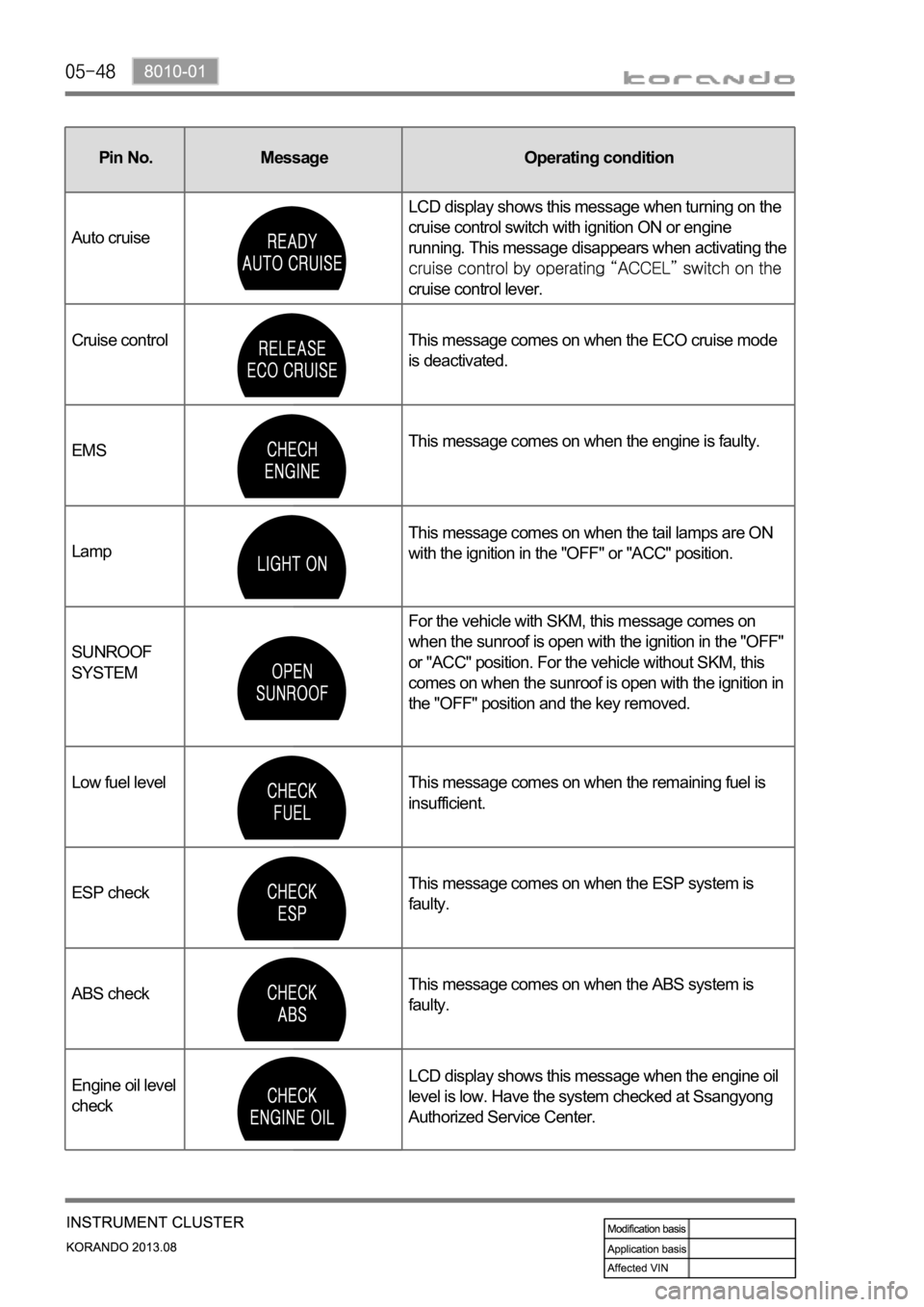
Pin No.Message
Operating condition
Domestic Export
Cruise control This message comes on when the ECO cruise mode
is deactivated.
EMSThis message comes on when the engine is faulty.
LampThis message comes on when the tail lamps are ON
with the ignition in the "OFF" or "ACC" position.
SUNROOF
SYSTEMFor the vehicle with SKM, this message comes on
when the sunroof is open with the ignition in the "OFF"
or "ACC" position. For the vehicle without SKM, this
comes on when the sunroof is open with the ignition in
the "OFF" position and the key removed.
Low fuel level This message comes on when the remaining fuel is
insufficient.
ESP checkThis message comes on when the ESP system is
faulty.
ABS check This message comes on when the ABS system is
faulty.
Engine oil level
checkLCD display shows this message when the engine oil
level is low. Have the system checked at Ssangyong
Authorized Service Center.Pin No. Message Operating condition
Auto cruiseLCD display shows this message when turning on the
cruise control switch with ignition ON or engine
running. This message disappears when activating the
cruise control lever.
Page 866 of 1336
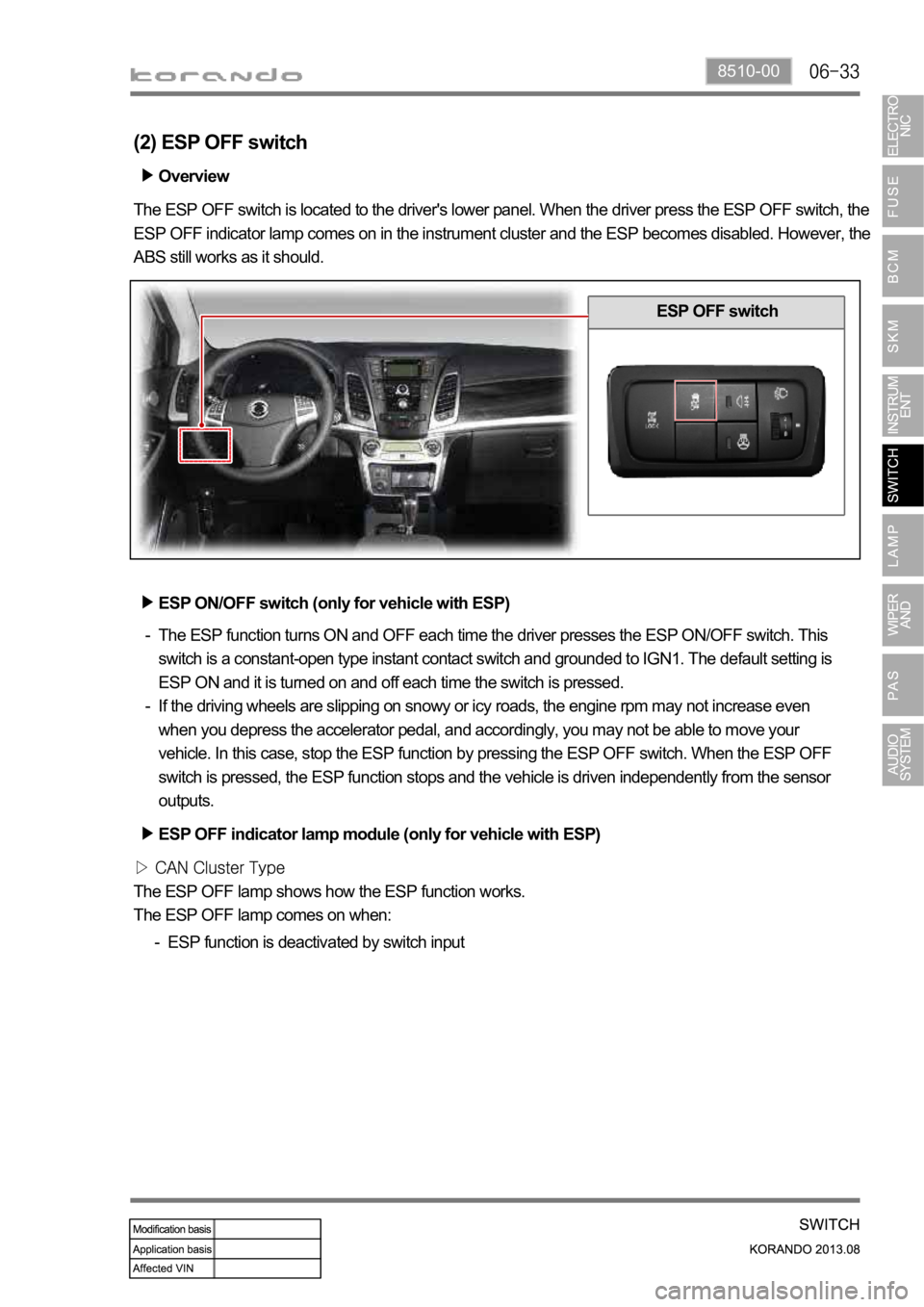
8510-00
Overview
The ESP OFF switch is located to the driver's lower panel. When the driver press the ESP OFF switch, the
ESP OFF indicator lamp comes on in the instrument cluster and the ESP becomes disabled. However, the
ABS still works as it should.
ESP ON/OFF switch (only for vehicle with ESP)
ESP OFF switch
(2) ESP OFF switch
ESP OFF indicator lamp module (only for vehicle with ESP)
The ESP function turns ON and OFF each time the driver presses the ESP ON/OFF switch. This
switch is a constant-open type instant contact switch and grounded to IGN1. The default setting is
ESP ON and it is turned on and off each time the switch is pressed.
If the driving wheels are slipping on snowy or icy roads, the engine rpm may not increase even
when you depress the accelerator pedal, and accordingly, you may not be able to move your
vehicle. In this case, stop the ESP function by pressing the ESP OFF switch. When the ESP OFF
switch is pressed, the ESP function stops and the vehicle is driven independently from the sensor
outputs. -
-
The ESP OFF lamp shows how the ESP function works.
The ESP OFF lamp comes on when:
ESP function is deactivated by switch input -
Page 951 of 1336
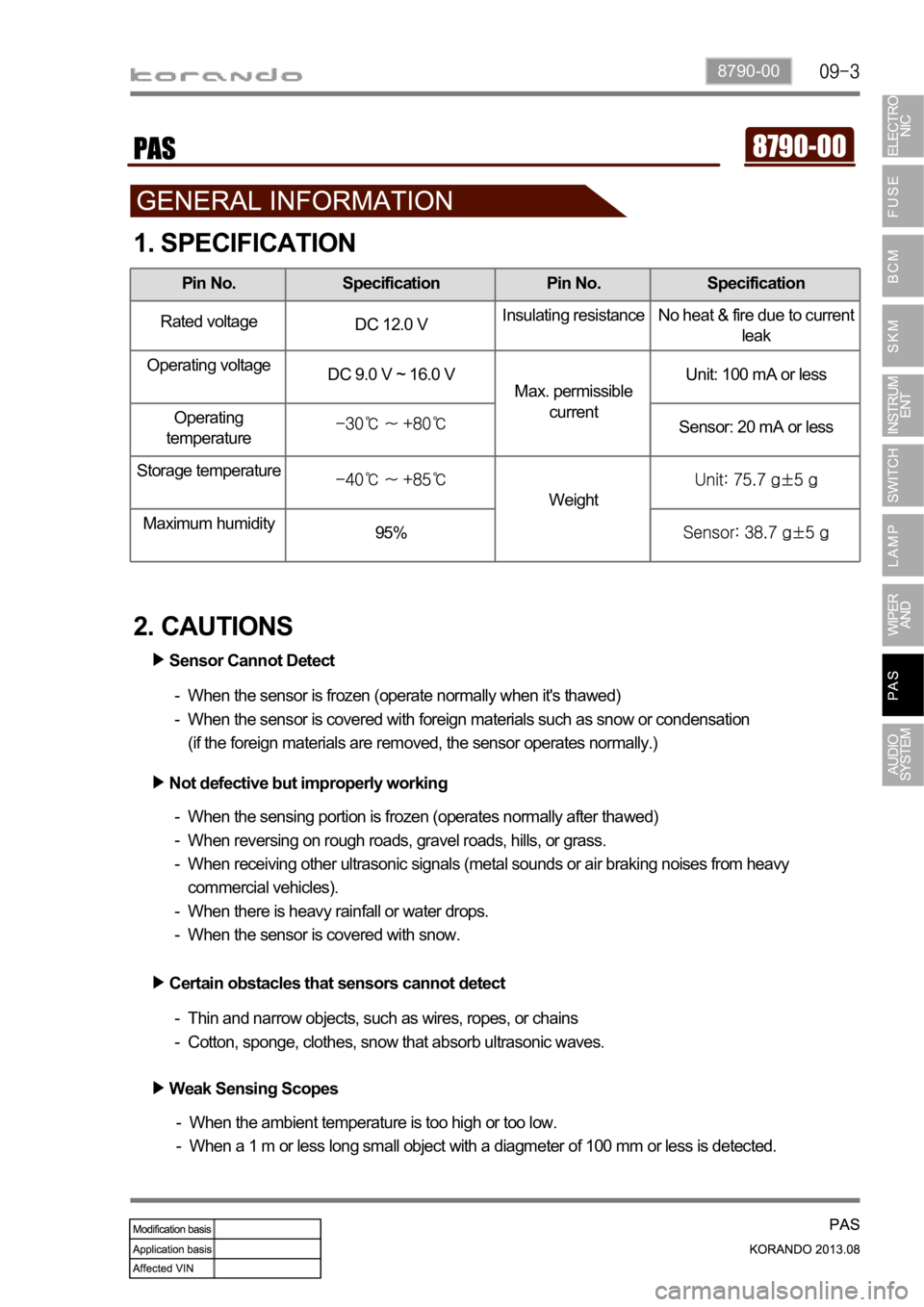
8790-00
1. SPECIFICATION
Pin No. Specification Pin No. Specification
Rated voltage
DC 12.0 VInsulating resistance No heat & fire due to current
leak
Operating voltage
DC 9.0 V ~ 16.0 V
Max. permissible
currentUnit: 100 mA or less
Operating
temperature
Sensor: 20 mA or less
Storage temperature
Weight
Maximum humidity
95%
2. CAUTIONS
Sensor Cannot Detect
When the sensor is frozen (operate normally when it's thawed)
When the sensor is covered with foreign materials such as snow or condensation
(if the foreign materials are removed, the sensor operates normally.) -
-
Not defective but improperly working
When the sensing portion is frozen (operates normally after thawed)
When reversing on rough roads, gravel roads, hills, or grass.
When receiving other ultrasonic signals (metal sounds or air braking noises from heavy
commercial vehicles).
When there is heavy rainfall or water drops.
When the sensor is covered with snow. -
-
-
-
-
Certain obstacles that sensors cannot detect
Thin and narrow objects, such as wires, ropes, or chains
Cotton, sponge, clothes, snow that absorb ultrasonic waves. -
-
Weak Sensing Scopes
When the ambient temperature is too high or too low.
When a 1 m or less long small object with a diagmeter of 100 mm or less is detected. -
-
Page 984 of 1336

HECU (Hydraulic & Electronic Control Unit)
HECU for ABS HECU for EPS
The HECU (Hydraulic & Electronic Control Unit) determines the slip conditions of vehicle wheels by
calculating each wheel's speed and the increment/decrement of speed based on the information
detected by the sensors, and controls the pumping and boosting/reducing/keeping pressure by
operating the valve and motor of HECU.
2. MOUNTING LOCATIONS (CHASSIS)
Moto
HU (Hydraulic Unit) ECU (Electronic
Control Unit) Moto
HU
(Hydraulic Unit) ECU (Electronic
Control Unit)
Motor
angle (8P)
Motor power (3P)Torque angle
sensor (8P) Battery (2P) Connector to
vehicle (8P)
Fuse for EPS
Steering wheel angle sensor (SWAS)
The steering wheel angle sensor is mounted between the
steering column and the steering column shaft. It is
commonly used by the ESP (Electronic Stability Program)
system. And it receives signals of the steering wheel angle
sensor from the ESP HECU (Hydraulic & Electronic
Control Unit).
EPS unit
The ECU controls the electric power steering
system depending on the driving conditions,
based on the signals from the torque and
angle sensor.
E-coupling unit
The E-coupling unit is a control unit
which determines the magnetic force by
considering CAN signals (wheel speed,
engine torque, pedal opening, ABS/ESP
CAN signals, etc.) from other ECUs.
Page 985 of 1336
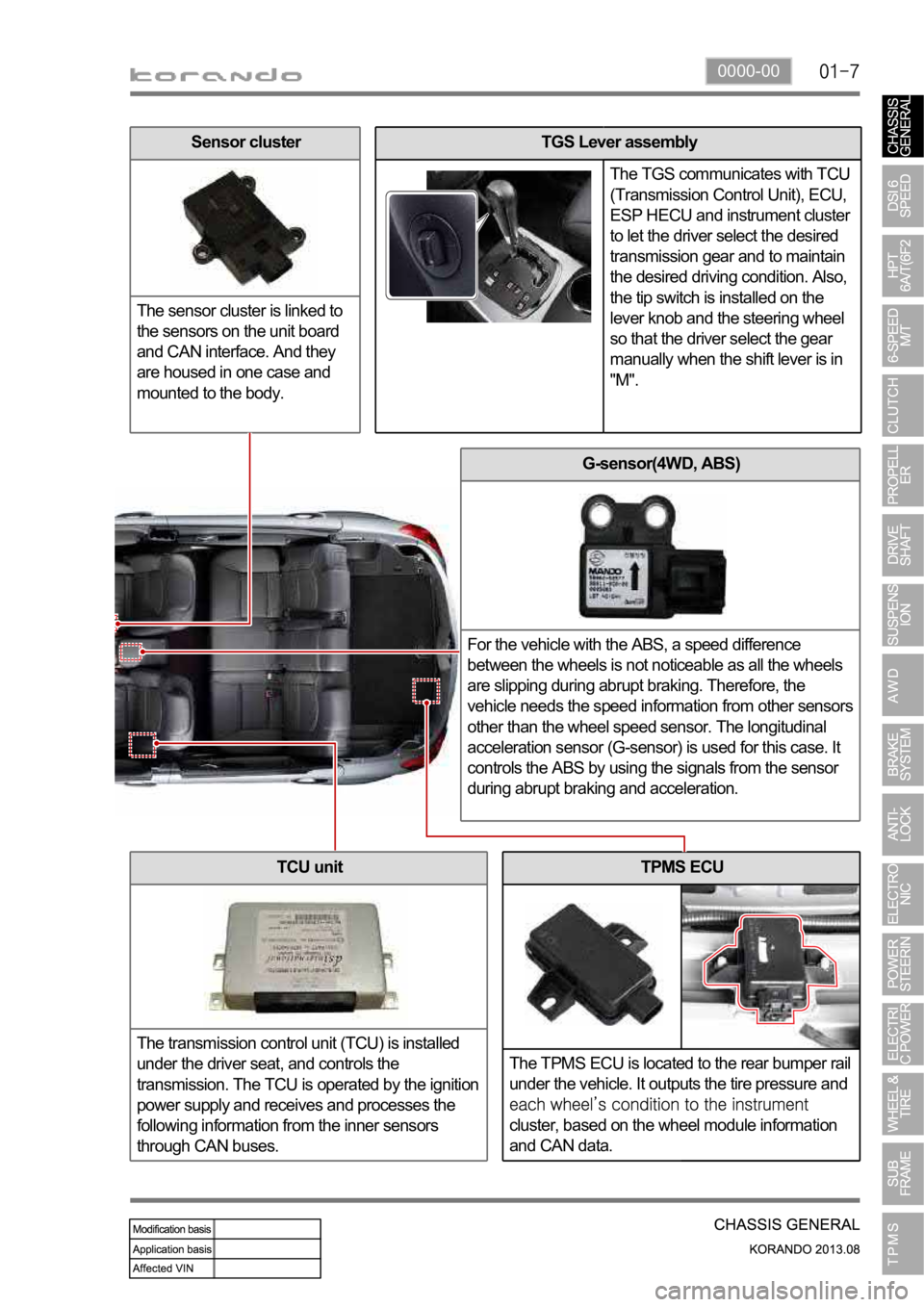
0000-00
TPMS ECU
The TPMS ECU is located to the rear bumper rail
under the vehicle. It outputs the tire pressure and
cluster, based on the wheel module information
and CAN data.
G-sensor(4WD, ABS)
For the vehicle with the ABS, a speed difference
between the wheels is not noticeable as all the wheels
are slipping during abrupt braking. Therefore, the
vehicle needs the speed information from other sensors
other than the wheel speed sensor. The longitudinal
acceleration sensor (G-sensor) is used for this case. It
controls the ABS by using the signals from the sensor
during abrupt braking and acceleration.
TCU unit
The transmission control unit (TCU) is installed
under the driver seat, and controls the
transmission. The TCU is operated by the ignition
power supply and receives and processes the
following information from the inner sensors
through CAN buses.
TGS Lever assembly
The TGS communicates with TCU
(Transmission Control Unit), ECU,
ESP HECU and instrument cluster
to let the driver select the desired
transmission gear and to maintain
the desired driving condition. Also,
the tip switch is installed on the
lever knob and the steering wheel
so that the driver select the gear
manually when the shift lever is in
"M".Sensor cluster
The sensor cluster is linked to
the sensors on the unit board
and CAN interface. And they
are housed in one case and
mounted to the body.
Page 986 of 1336

A/T assembly
Automatic transmission is available as 4WD- and 2WD-type,
and provides 6 speeds for forward travel and 1 reverse
travel. It is also equipped with the torque converter with inner
lock-up clutch and electronically controlled solenoid which
controls all hydraulic functions.
3. CHASSIS COMPONENT LAYOUT
PTU (Power Transfer Unit)
The PTU is a device that transfers the power
generated from the engine to the rear axle through
propeller shaft and E-coupling by changing the power
4WD vehicle.Rear axle assembly
The rear axle installed in this car is a removable
axle, called IRDA (Independent Rear Differential
Axle). The rear differential carrier is installed
directly on the sub frame, and there is an
independent suspension that allows each wheel
on the same axle to move vertically independentl
y
of each other with the universal joint and the slip
joint.
E-coupling control unit (E-Coupling ECU)
The E-coupling unit is a control unit which determines
the magnetic force by considering CAN signals (wheel
speed, engine torque, pedal opening, ABS/ESP CAN
signals, etc.) from other ECUs.
Inhibitor switch
Torque converter Oil pan
E-coupling sideRear axle side
Propeller shaft
1) 4WD Vehicle With Automatic Transmission
GSLDSLInhibitor switch
Torque converter Oil pan
Page 990 of 1336
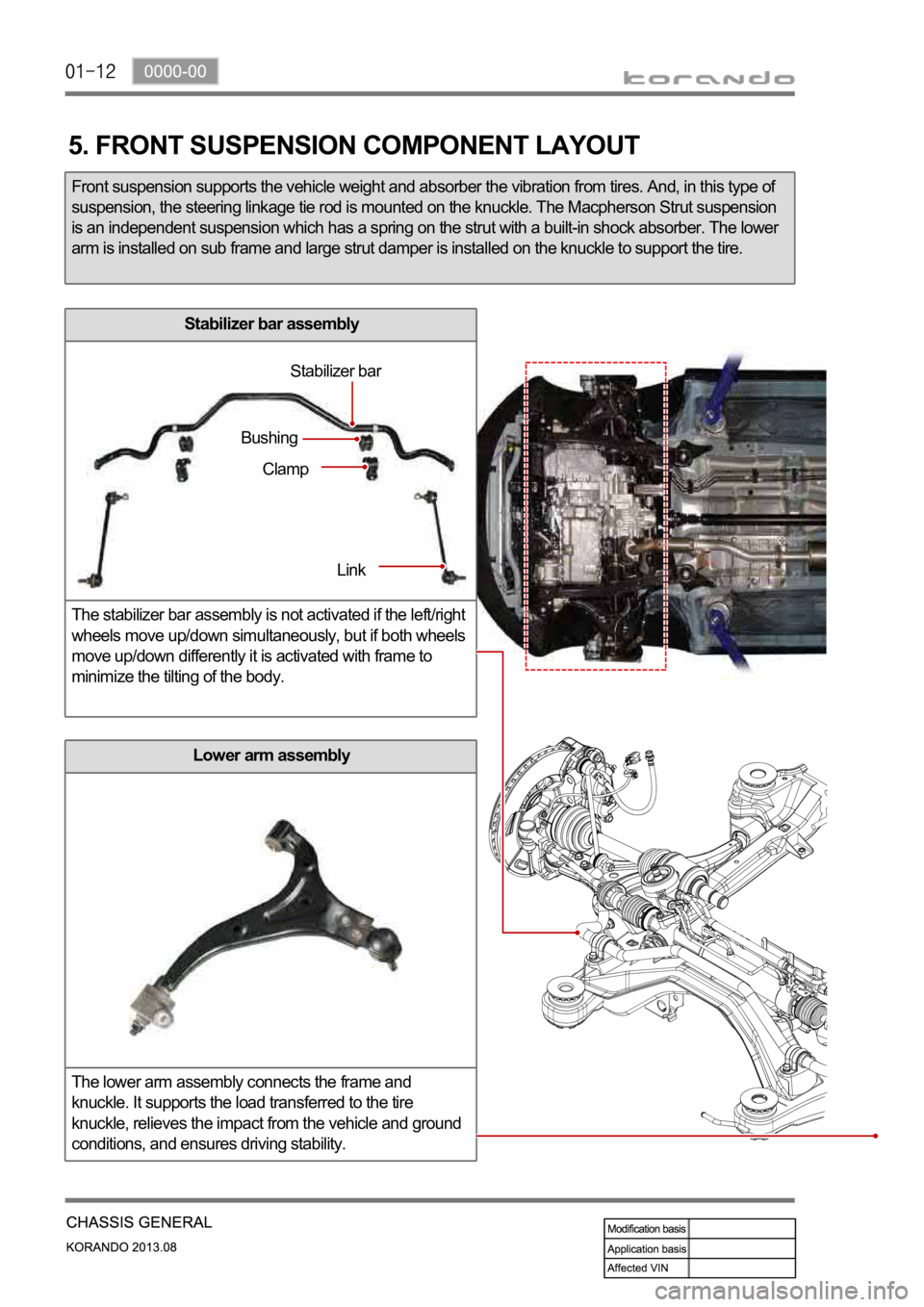
Stabilizer bar assembly
The stabilizer bar assembly is not activated if the left/right
wheels move up/down simultaneously, but if both wheels
move up/down differently it is activated with frame to
minimize the tilting of the body.
5. FRONT SUSPENSION COMPONENT LAYOUT
Front suspension supports the vehicle weight and absorber the vibration from tires. And, in this type of
suspension, the steering linkage tie rod is mounted on the knuckle. The Macpherson Strut suspension
is an independent suspension which has a spring on the strut with a built-in shock absorber. The lower
arm is installed on sub frame and large strut damper is installed on the knuckle to support the tire.
Lower arm assembly
The lower arm assembly connects the frame and
knuckle. It supports the load transferred to the tire
knuckle, relieves the impact from the vehicle and ground
conditions, and ensures driving stability.
Stabilizer bar
Bushing
Clamp
Link
Page 991 of 1336

0000-00
Front coil spring assembly
The coil spring is made by winding solid steel rod to form
the coil shape. Its energy absorption rate per weight is
higher than that of the leaf spring and it allows to absorb
small vibration properly resulted in keeping the ride
comforts. Therefore, it's difficult to make an effect on
vibration damping because there is not any friction
between coils.
Coil spring
Shock absorber assembly